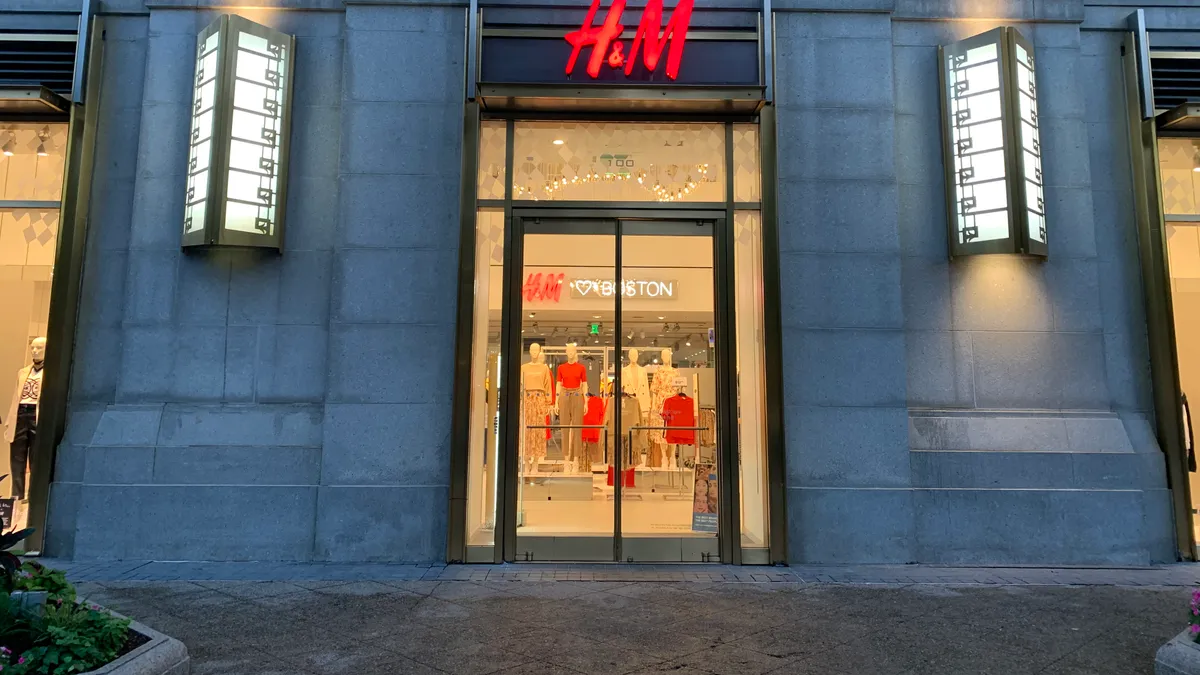Dive Brief:
-
H&M on Thursday reported that third quarter net sales rose 12% to 62.6 billion Swedish krona ($6.36 billion, according to the exchange rate at press time) in the third quarter, thanks to "well-received summer collections." Online sales rose 30% in Swedish krona as new business rose 18%, according to a company press release.
-
Gross profit in the quarter expanded by 13% to 31.8 billion Swedish krona, corresponding to a gross margin of 50.8%, up from 50.3% a year ago, the company said. Despite external pressures like the strong U.S. dollar, costs for markdowns in relation to sales decreased by about 2 percentage points year over year.
-
Profit after financial items rose 25% to 5 billion Swedish krona, and the group's after-tax profit rose to 3.86 billion Swedish krona from $3.1 billion in the year-ago quarter. Operating profit rose 26% in the quarter, the first increase since the second quarter two years ago, according to GlobalData research.
Dive Insight:
H&M's new strategy, which has entailed scaling back previous plans for a brick-and-mortar expansion, stoking e-commerce and amplifying sustainability efforts in manufacture and at retail, is gaining traction.
"H&M's strategic overhaul, in which the value player has embraced the shift away from physical retail to digital, is beginning to reap rewards, with increased full-price sales and lower markdowns, resulting in double-digit growth in operating profit – its first rise since Q2 FY2016/17," GlobalData Lead Retail Analyst Kate Ormrod said in emailed comments.
The fast-fashion retailer's pullback from opening stores, with a net 120 new locations this year from about 175 in April, doesn't apply across the board, however, CEO Karl-Johan Persson noted in a statement Thursday. "In parallel with the integration of stores and online shopping we keep optimising the store portfolio, including more consolidation in established markets and expansion in growth markets," he said.
In stark contrast to previous tactics, the company has embraced e-commerce and omnichannel fulfillment, with "continued rollout of Click & Collect and online returns in store, along with improved search functions, more flexible payment options and faster deliveries," he also said.
It doesn't hurt that company hit its marks in fashion, no small feat in an era when consumers don't need to buy so much apparel, and are choosy when they do. But its attention to customer tastes goes beyond design, and H&M is setting out to prove that fast fashion can rise to the sustainability challenge that consumers have set.
It's not like H&M is abandoning the fast-fashion proposition. The company continues to invest in its supply chain in order to protect the swift product turnover that Ormrod notes is "crucial for those in the fast fashion segment," saying "Investment in its supply chain, and the plan to open a new logistics centre in Milton Keynes this autumn will aid product availability and speed."
But it's also doubling down on its environmental initiatives on several fronts, with what Persson termed the "best combination of fashion, quality, price and sustainability." The group noted in its release that it's ranked as one of the world's best retailers for sustainability in the Dow Jones Sustainability World Index. Last month, the company announced packaging reform efforts and embraced initiatives toward energy efficiency and circular production.
"Its longstanding commitment to sustainability sets it apart from other value players and with new initiatives such as green home delivery (for example via cars that run on biogas) in the Netherlands and trialing clothing rental in Stockholm in the autumn, H&M has found its niche which it can continue to exploit as consumer focus on sustainability grows," Ormrod said.
That threatens to leave rival Forever 21 that much further behind. The U.S. player in the segment entered Chapter 11 this week, with nary a nod to sustainability in the comeback plans laid out in bankruptcy court documents so far.
The company faces plenty of challenges, however, Ormrod warned. While digital sales have accelerated each quarter this fiscal year, "continued investment is necessary to stay competitive," as other players also ramp up and, in the case of rival Primark, enter e-commerce. And some efforts may not have much of an impact, notably H&M's reported move to sell third-party brands through its namesake stores.
"While the idea holds merit to extend its reach and bolster appeal, with sister brands & Other Stories and Arket already selling external brands, taking on ASOS and Zalando is a big ask, so third-party brands are unlikely to become a cornerstone of its proposition," Ormrod said.














